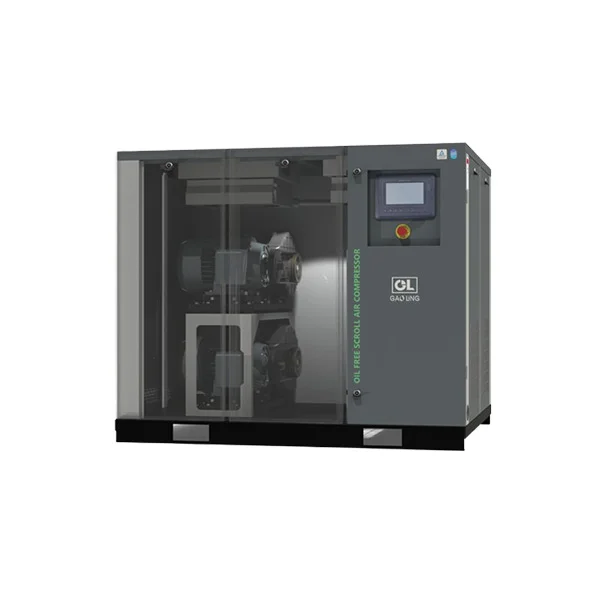Belt-type air compressors, a crucial piece of equipment commonly used in industrial production, are widely used in factories, workshops, and laboratories due to their simple structure, easy maintenance, and relatively low investment costs. However, over time, various faults are inevitable, which not only impact production efficiency but can also increase equipment maintenance costs. Therefore, understanding common belt-driven air compressor faults and their causes is crucial for improving equipment reliability and extending its service life.
1. Working Principle of Belt-type Air Compressors
Belt-driven air compressors typically consist of a motor, a drive belt, a compressor body, a cooling system, and a control system. Their basic operating principle is that the motor drives a pulley, rotating the piston or blades inside the compressor, drawing in air, compressing it to a set pressure, and then delivering it. Because of the belt drive, there's a certain buffering effect between the motor and the compressor body. This design can mitigate mechanical shock to a certain extent, but it can also be prone to failure due to belt problems.
2. Common Faults and Causes of Belt-Driven Air Compressors
2.1 The air compressor is not delivering air or delivering insufficient air.
This is one of the most common problems with belt-driven air compressors. This type of failure is typically caused by the following reasons:
Improper belt tension: If the drive belt is too loose, power transmission is insufficient, and the compressor cannot achieve sufficient speed, resulting in reduced air output. Conversely, an overly tight belt increases the load on the motor, affecting efficiency.
Clogged air filter: If the air filter has not been cleaned for a long time, dust accumulation can obstruct air intake, resulting in reduced air output.
Valve failure: Damaged or poorly sealed intake or exhaust valves can cause compressed air leakage, resulting in insufficient air output.
Compressor wear: Excessive wear on the piston rings or cylinder walls reduces compression efficiency and also affects air output.
Maintenance recommendations: Regularly checking the belt tension, cleaning the air filter, and replacing damaged valves and worn parts can effectively address insufficient air output.
2.2 Compressor Startup Difficulty or Motor Overload: If the motor of a belt-operated air compressor is overloaded or has difficulty starting, it may cause the motor to trip frequently or burn out. Common causes include:
Belt slippage or excessive friction: An aging or improperly tensioned belt can increase the load on the motor. Poor lubrication: Insufficient lubrication of the compressor's internal bearings or pistons increases friction and starting resistance.
Abnormal power supply voltage: Low voltage can cause difficulty starting the motor, while high voltage can increase the risk of damage.
Mechanical jamming: Jamming or obstruction of internal compressor parts can also affect starting.
Maintenance Recommendation: Check the belt condition, lubrication system, power supply voltage, and internal components to ensure smooth starting.
2.3 Excessive Compressor Noise
Excessive noise during operation not only affects the working environment but may also be a precursor to potential failures. Possible causes include:
Loose or worn belts: Loose belts can produce grinding or whipping sounds at high speeds.
Bearing damage: Bearing wear or lack of oil can produce a harsh metallic friction sound.
Casing resonance: Unstable equipment installation or base vibration can amplify mechanical noise.
Loose internal parts: Loose screws or nuts or excessive clearance between components can also increase noise.
2.4 Compressor Overheating
Belt-operated air compressors are prone to overheating after prolonged operation, which reduces efficiency and shortens the equipment life. Common causes include:
Insufficient or deteriorating lubricant: Poor lubrication increases friction and leads to elevated temperatures.
Poor heat dissipation: A damaged cooling fan or clogged heat sink can cause heat buildup.
Clogged air filter: Air intake is blocked, increasing the load on the compressor.
Continuous high-load operation: Operating the equipment beyond its designed capacity can cause overheating.
Maintenance recommendations: Regularly replace lubricants, clean the cooling system, and avoid prolonged full-load operation.

2.5 Water or Oil Contamination in Compressed Air
Air quality is particularly important in industrial production, and belt-operated air compressors may experience water or oil contamination in the air. Causes include:
Untimely condensate drainage: Compressed air cools in the pipes, forming water droplets. A clogged drainage system can lead to excessively high humidity.
Lubricant leakage: Poor seals in the lubrication system of piston compressors can allow lubricant to enter the air passages.
Damaged air filter: A failed filter can cause impurities and oil mist to be discharged with the air.
Maintenance recommendations: Regularly drain condensate, replace seals, and replace air filters to maintain clean air.
2.6 Unstable Pressure
Unstable output pressure from belt-operated air compressors directly impacts production quality. Common causes include:
Pressure regulating valve failure: Inaccurate valve adjustment leads to pressure fluctuations.
Belt slippage: Unstable transmission causes compressor speed fluctuations, affecting output pressure.
Air leakage: Poor sealing of pipes and interfaces can cause pressure drops or fluctuations.
Maintenance recommendations: Check the pressure regulating system, belt condition, and pipe seals to ensure stable pressure.
3. Belt-Type Air Compressor Failure Prevention and Maintenance Recommendations
Regularly check belt condition: Proper belt tension, free of cracks or wear, are key to ensuring power transmission and stable equipment operation.
Maintain a healthy lubrication system: Regularly change lubricating oil and inspect the lubrication system for blockages or leaks.
Clean the air filter and cooling system: Ensure smooth air intake and effective heat dissipation, reducing the risk of failure.
Ensure power supply stability: Avoid excessive voltage fluctuations to protect motor safety.
Establish a daily inspection system: Regularly check screw tightness, bearing wear, drainage system, and valve condition. The above measures can effectively reduce the failure rate of belt-type air compressors, extending their service life and production efficiency.
4. Conclusion
Despite their simple structure, belt-type air compressors can still experience common faults over long-term use, such as insufficient air output, difficulty starting, excessive noise, overheating, and unstable pressure. These issues are mostly related to belt tension, lubrication, valves, air filters, and power supply stability. Regular maintenance, scientific care, and troubleshooting can significantly reduce equipment failure rates and ensure smooth industrial production.
For businesses, understanding the common causes of belt-type air compressor failures and developing appropriate preventative measures is crucial for improving production efficiency, reducing operating costs, and extending equipment life. Only through proper selection, standardized operation, and timely maintenance can industrial belt-type air compressors maximize their value in production.
As a professional belt-type air compressor distributor, we not only provide high-quality, energy-saving belt-type air compressors, but also offer comprehensive technical support and after-sales service. Whether it's troubleshooting in industrial production, routine maintenance guidance, or equipment selection recommendations, we can provide professional solutions based on actual needs to help companies improve production efficiency, reduce operating costs, and ensure the long-term stable operation of belt-type air compressors to maximize their value.
www.glcompressor.com
glcompressor
